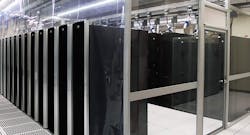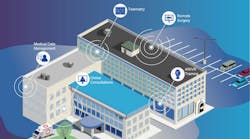In this week’s Voices of the Industry, Ward Patton, Critical Environment Specialist at Simplex Isolation Systems, unpacks five key considerations for airflow containment design.
Data center containment systems can provide great benefits over traditional open data center designs. By implementing an effective airflow containment strategy, it is possible to see optimized cooling system efficiency, improved Power Usage Effectiveness (PUE) and additional equipment capacity, all without having to expand a facility’s footprint.
Ward Patton, Critical Environment Specialist at Simplex
Like any successful system, airflow containment design must consider many different factors to ensure a solution that achieves the required cooling, while remaining flexible for expansion or changes and integrates well with the current infrastructure. Here are five key considerations to keep in mind when planning a data center containment project.
- Hot Aisle or Cold Aisle Containment
Hot air and cold air containment are the two high-level methods of an airflow containment strategy, and there is an ongoing discussion in the industry about whether it makes more sense to isolate the hot aisle or the cold aisle. Different data center experts advocate different theories, but realistically, the approach should be dictated by the existing infrastructure.
For example, what is the current air distribution type in the facility? This will play a critical role in deciding which approach is the best fit. Data centers with targeted return and flooded supply air distribution would benefit more from hot aisle containment, whereas data centers with targeted supply and flood return air distribution would see better results with cold aisle containment.
[clickToTweet tweet=”Ward Patton – Data center containment systems can provide great benefits over traditional open data center designs. ” quote=”Ward Patton – Data center containment systems can provide great benefits over traditional open data center designs. “]
Additional factors that can dictate whether to isolate the hot aisle or the cold aisle include the depth of the raised floor plenum, the presence of overhead cabling, varied ceiling heights and support column locations. These are only some of the infrastructure constraints that need to be addressed and every case is site specific. An assessment of the existing conditions of the facility is essential to choosing the right containment solution for any data center.
- IT Equipment Arrangement
Once the infrastructure has been evaluated, the next step is to review the current IT equipment arrangement. While most data centers are depicted having rows and rows of server racks of the same brand, shape and size, this is rarely the case. It is not uncommon to see offset rows consisting of multiple server rack brands in all number of shapes and sizes. This is especially true for legacy data centers that have undergone expansion, or are the result of the consolidation of multiple facilities.
It is also recommended to go one step further and review any ergonomic challenges. Factors such as clearance or personnel traffic should be reviewed and planned for accordingly. End-of-aisle doors for instance, should be configured to best fit the traffic patterns within the data center making the space easier to work in when moving racks and other items in and out.
When evaluating an airflow containment system, it is critical to assess the amount of customization that will be needed for the containment system to perform optimally, especially if there is a lack of uniformity with the IT equipment. While it may seem daunting to find a containment system that can accommodate all levels of variation, most innovative manufacturers can offer a customized and flexible solution to fit any new or retrofit application.
- Fire Detection and Suppression
Fire suppression in the data center is complicated and involved. It is a good policy to involve the local Fire Marshal as soon as possible when planning an airflow containment system. The Fire Marshal enforces the local codes and standards in the jurisdiction and can play a critical role in providing the insight needed to achieve compliance from the very beginning.
[clickToTweet tweet=”Fire suppression in the data center is complicated and involved. #cooling” quote=” Fire suppression in the data center is complicated and involved. #cooling”]
Jurisdictions will require compliance with the National Fire Protection Association (NFPA) 75 and 76, which ensure that fire suppression systems are in place and meet specific testing requirements. From a containment standpoint, these standards require data center facilities who use an airflow containment system to either have a fire suppression system that covers all areas of contained aisles or a containment system that integrates with the fire detection system. The former option can be a costly and daunting task, so many data center managers will opt for a containment system that works with the current fire suppression infrastructure.
There are many reputable containment systems available today that are designed specifically for use under a fire suppression system, though potential implications associated with the containment approach will still need to be considered. Vertical containment systems that incorporate softwall curtains, for example, would need to account for the required clearance space below the sprinkler level if the facility is equipped with a sprinkler-based fire suppression system. This would insure full dispersal of water in the event of a fire. Such systems would also need to consider what softwall material is being implemented. It’s not uncommon to receive demands from the Fire Marshal to source curtain materials that meet the stringent ASTM E-84 Class 1 rating for flame and smoke generation, so researching and selecting an appropriate softwall material is important.
Systems that feature ceiling partitions rather than softwall curtains will need to address how the facility’s fire suppression system will be accommodated. These structures generally include ceiling panels that are retractable, are equipped with a soft drop system, or are designed to shrink and fall away when exposed to temperatures that reach 15 to 20 degrees lower that the temperature at which the fire sprinklers would activate.
Whatever the containment approach, there are additional factors to consider when evaluating which system is the best fit.
- A fail-safe system is key. Look for a containment system equipped for a facility power outage or Emergency Power Off (EPO) event. While many systems may tie into a dedicated emergency back-up supply, relying on a supplemental power system can’t be deemed fail-safe. Instead, consider a system that is inherently fail-safe, such as a gravity-reliant, electromagnetic droplink that would drop away when the power source is disconnected. That way the fire suppression system would still operate successfully in the event of a power outage.
- Consider equipment and personnel safety. Look for a system that won’t cause additional damage to equipment or prove harmful to personnel if deployed. Curtain systems for instance, should be equipped with a lanyard drop system and ceiling structures should retract or have a soft-drop feature to prevent damage when they are utilized.
- Testability. Look for a system that can be tested and reset in the event of deployment. This is a requirement for NFPA 75 compliance.
When it comes to prevention against a fire within the data center, any costs related to risk mitigation will be justified when compared to the cost of damage that would be incurred in the event of an actual fire.
- Electrical Utility Incentives
There is a good chance that your electrical utility provider has a system of rebates and incentives for companies that take proactive measures to decrease power usage in their data centers. The utility might have certain stipulations in place such as approved contractors, approved equipment and other requirements. Take these considerations into account as you begin the design process, rather than after the airflow containment project is underway. There are often specific time windows to take advantage of these incentives.
- Future Growth
Understand that change is unavoidable and design the airflow containment based on that reality. Eventually changes in the data center will be required to accommodate growth or reconfigure the layout. When evaluating an airflow containment system, it makes sense to look for components and structures that are modular in design. Modular mounting hardware for curtains and modular end-of-aisle doors, for example, can be relocated or expanded upon if needed. Ultimately, containment systems that are modular in design will have a lower cost of ownership.
Overall, data centers are complicated and there are many factors that come into play when designing an effective airflow containment solution. When making plans for airflow containment, it is recommended to work with reputable manufacturers that can analyze the space and align airflow and containment objectives with the data center’s site-specific infrastructure and equipment requirements to secure the greatest efficiencies and enable modular, scalable and affordable growth.
Ward Patton is the Critical Environment Specialist at Simplex Isolation Systems. Simplex Isolation Systems designs and manufactures custom data center containment systems that are modular, expandable and high-performing. Simplex’s Containment Resource Guide can serve as an essential tool for planning a hot or cold aisle containment system.





